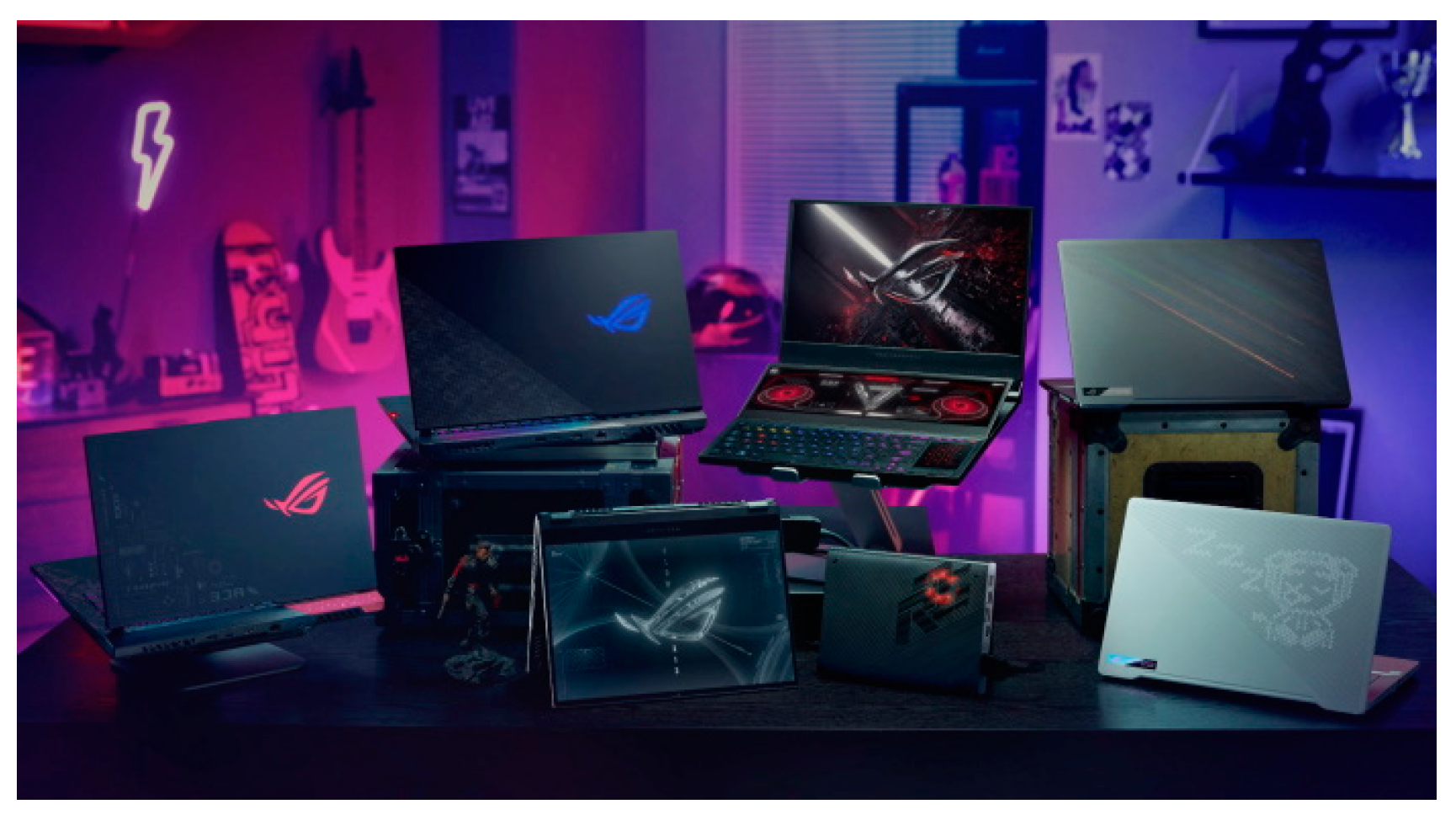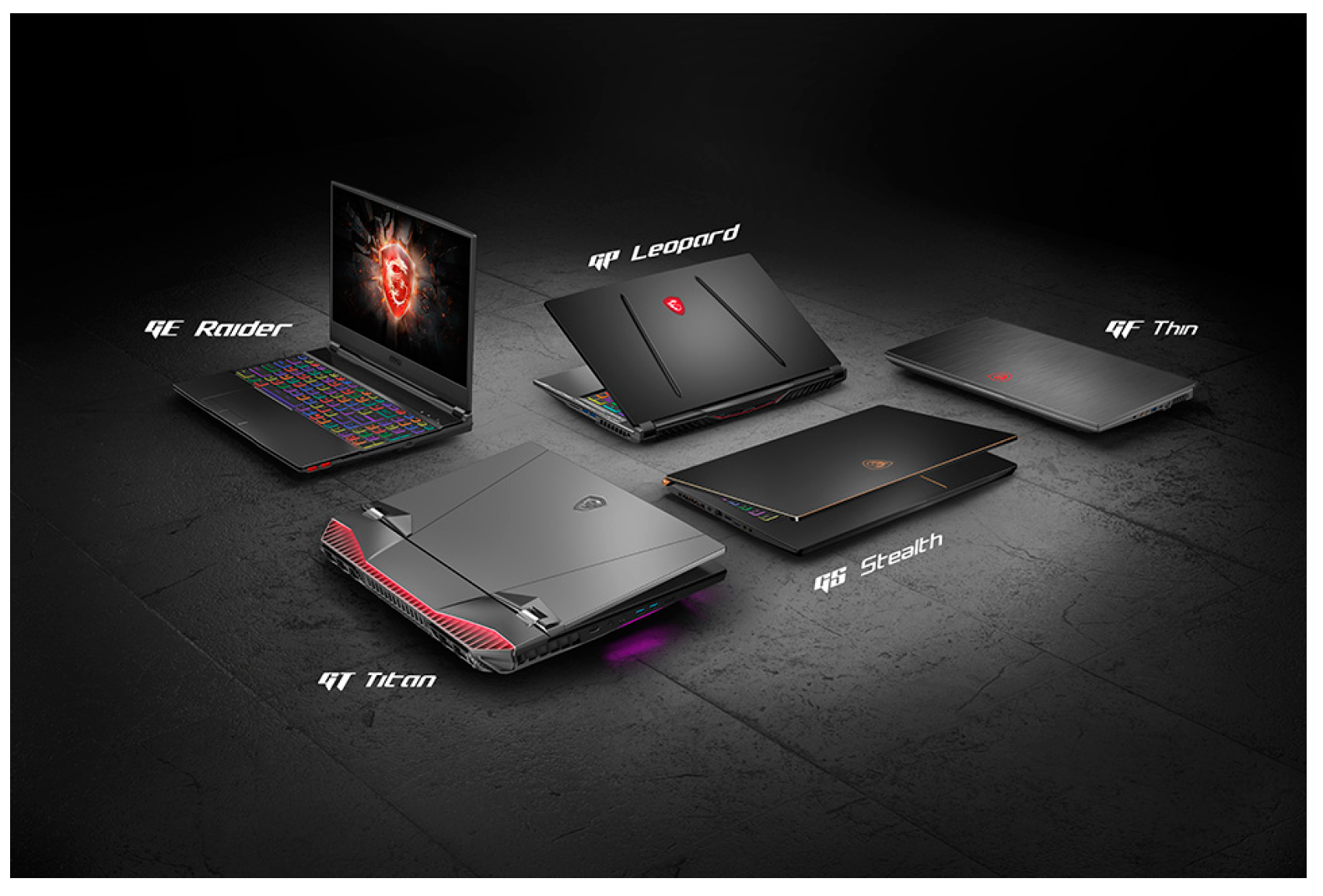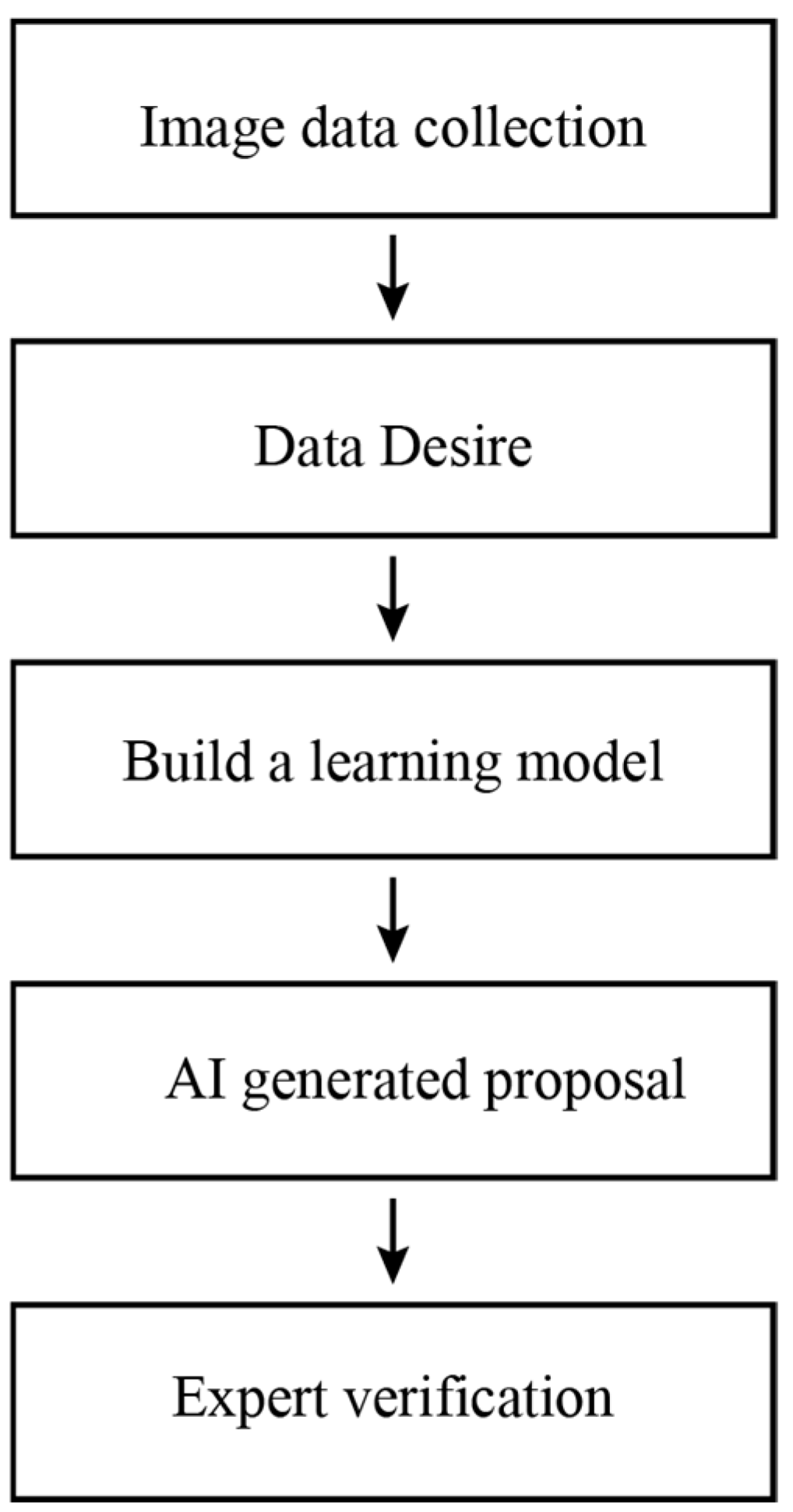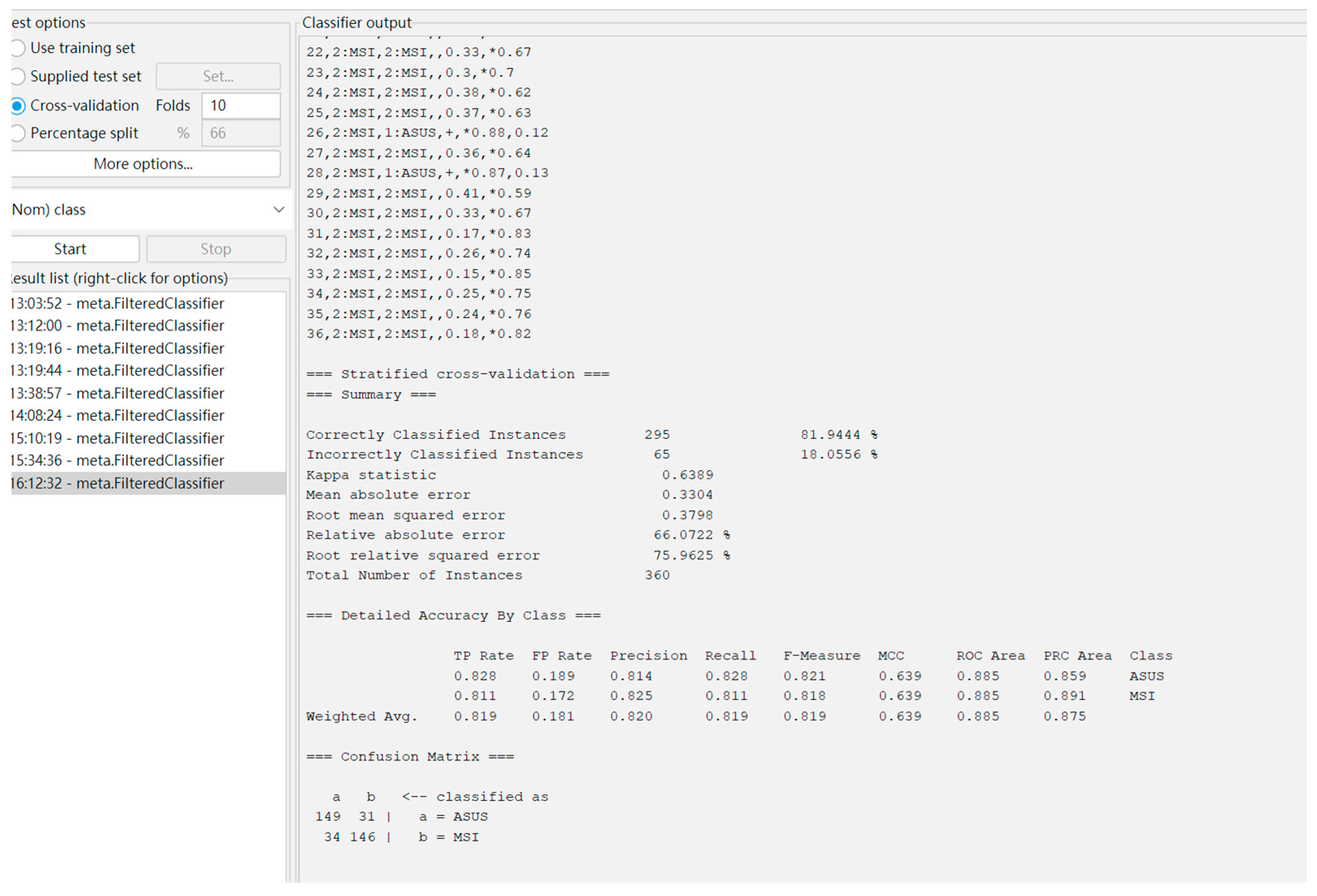Developing Weka-Based Image Classification Learning Model: Enhancing Novice Designers’ Recognition of Brand Typicality †
Abstract
:1. Introduction
2. Literature Review
2.1. Brand Identity and Product Design
2.2. Deep Learning and Image Recognition
2.3. AI-Assisted Product Design
- ChatGPT 4.0 (DALL-E 2) excels at generating high-resolution, detailed images from textual descriptions, supporting educational processes by illustrating concepts and styles [13].
- Midjourney focuses on artistically inspired images with powerful stylized expressive capabilities, ideal for creative visual expression [14].
- Stable Diffusion uses diffusion model technology to fine-tune styles while maintaining image quality, making it suitable for generating diverse high-quality images, crucial for visual concepts and projects [15].
2.4. Case Selection: Asus and MSI
3. Research Procedure
3.1. Data Collection and Preprocessing
3.2. Model Training and Testing
3.2.1. Training Process
3.2.2. Keyword Preparation
3.2.3. Image Generation
3.2.4. Machine Learning Classification Results
3.2.5. Analysis of WEKA Experimental Results
3.2.6. Expert Qualitative Analysis
3.3. Expert Qualitative Results Analysis
- Graphics Cards and Chassis: The inconsistency between expert and Weka classifications in these categories, especially the misclassification of Graphics Card 2 and Chassis 6, highlights the cognitive challenges posed by visual style similarities. This indicates that even experts are confused by design elements with subtle differences.
- Laptops: Weka made a classification error with Laptop 6, and designers A and B also misjudged Laptops 2 and 4, reflecting the risk of misjudgment even with significant brand designs, particularly when product designs are close to or mimic competitors.
- Mice and Headsets: The classification errors for mice and headsets demonstrate the limitations of using visual identification to distinguish brand characteristics in highly similar product categories. Particularly in the headset category, Designer B’s misclassification of Headsets 3 and 4 highlights the subjective differences in brand style interpretation even among experts.
4. Conclusions
Author Contributions
Funding
Institutional Review Board Statement
Informed Consent Statement
Data Availability Statement
Conflicts of Interest
References
- Hsu, C.-L.; Chen, Y.-C.; Yang, T.-N.; Lin, W.-K.; Liu, Y.-H. Does product design matter? Exploring its influences in consumers’ psychological responses and brand loyalty. Inf. Technol. People 2018, 31, 886–907. [Google Scholar] [CrossRef]
- Zhang, Y. Research on key technologies of remote design of mechanical products based on AI. J. Vis. Commun. Image Represent. 2019, 60, 250–257. [Google Scholar] [CrossRef]
- Calò, T. Rethinking Design Workflows with Artificial Intelligence. In Proceedings of the CHItaly 2023: Crossing HCI and AI, Doctoral Consortium, Turin, Italy, 20–22 September 2023; pp. 8–14. [Google Scholar]
- Schmitt, B. Experiential marketing. J. Mark. Manag. 1999, 15, 53–67. [Google Scholar] [CrossRef]
- Kapferer, J.-N. The New Strategic Brand Management: Advanced Insights and Strategic Thinking; Kogan Page Publishers: London, UK, 2012. [Google Scholar]
- Chen, W.; Xie, D.; Zhang, Y.; Pu, S. All you need is a few shifts: Designing efficient convolutional neural networks for image classification. In Proceedings of the IEEE/CVF Conference on Computer Vision and Pattern Recognition, Long Beach, CA, USA, 15–20 June 2019; pp. 7241–7250. [Google Scholar]
- LeCun, Y.; Bengio, Y.; Hinton, G. Deep learning. Nature 2015, 521, 436–444. [Google Scholar] [CrossRef] [PubMed]
- Goodfellow, I.; Pouget-Abadie, J.; Mirza, M.; Xu, B.; Warde-Farley, D.; Ozair, S.; Courville, A.; Bengio, Y. Generative adversarial nets. Commun. ACM 2020, 63, 139–144. [Google Scholar] [CrossRef]
- Wang, H.-H.; Chen, C.-P. A case study on evolution of car styling and brand consistency using deep learning. Symmetry 2020, 12, 2074. [Google Scholar] [CrossRef]
- Maher, M.L.; Weisz, J.D.; Chilton, L.B.; Geyer, W.; Strobelt, H. HAI-GEN 2023: 4th Workshop on Human-AI Co-Creation with Generative Models. In Companion Proceedings of the 28th International Conference on Intelligent User Interfaces; Association for Computing Machinery: New York, NY, USA, 2023; pp. 190–192. [Google Scholar]
- Weisz, J.D.; Maher, M.L.; Strobelt, H.; Chilton, L.B.; Bau, D.; Geyer, W. Hai-gen 2022: 3rd workshop on human-ai co-creation with generative models. In Proceedings of the 27th International Conference on Intelligent User Interfaces, Helsinki, Finland, 22–25 March 2022; pp. 4–6. [Google Scholar]
- Agersborg, C.; Månsson, I.; Roth, E. Brand Management and Artificial Intelligence—A World of Man Plus Machine: A Qualitative Study Exploring How Artificial Intelligence Can Contribute to Brand Management in the B2C Sector. Master’s Thesis, University of Gothenburg, Gothenburg, Sweden, 2020. Available online: https://gupea.ub.gu.se/handle/2077/64924 (accessed on 1 July 2024).
- Derevyanko, N.; Zalevska, O. Comparative analysis of neural networks Midjourney, Stable Diffusion, and DALL-E and ways of their implementation in the educational process of students of design specialities. Sci. Bull. Mukachevo State Univ. Ser. Pedagog. Psychol. 2023, 9, 36–44. [Google Scholar] [CrossRef]
- Wasielewski, A. “Midjourney can’t count”: Questions of representation and meaning for text-to-image generators. Interdiscip. J. Image Sci. 2023, 37, 71–82. [Google Scholar]
- Borji, A. Generated faces in the wild: Quantitative comparison of stable diffusion, midjourney and dall-e 2. arXiv 2022, arXiv:2210.00586. [Google Scholar]
- Caggiani, L.; Camporeale, R. Toward sustainability: Bike-sharing systems design, simulation and management. Sustainability 2021, 13, 7519. [Google Scholar] [CrossRef]
- Wang, C.-H.; Yun, Y. Demand planning and sales forecasting for motherboard manufacturers considering dynamic interactions of computer products. Comput. Ind. Eng. 2020, 149, 106788. [Google Scholar] [CrossRef]







| Product Category | Brand | Keyword Descriptions |
|---|---|---|
| Mouse | Asus | Precise sensors, customizable RGB lighting, ergonomic design, responsive buttons. |
| Laptop | Asus | Light and stylish, gray color scheme, subtle texture, elegant feel. |
| Headphones | Asus | Immersive sound, comfortable design, noise cancelation, customizable RGB lighting. |
| Monitor | Asus | Curved ultra-wide display, immersive gaming design, elegant silhouette. |
| Display Card | Asus | High performance, advanced cooling system, sleek design. |
| Chassis | Asus | Minimalist and stylish design, eye-catching housing, RGB lighting, modern esthetics. |
| Laptop | MSI | High-performance GPU, advanced cooling, dynamic design. |
| Mouse | MSI | High precision, fast reaction time, ergonomic design. |
| Head-phones | MSI | Restrained and stylish, shielded, durable construction. |
| Monitor | MSI | QHD resolution, ultra-narrow bezels, suitable for competitive gaming. |
| Chassis | MSI | Sharp facets, advanced components, modular housing design. |
| Product Category | Brand | Chat GPT | Midjourney | Stable Diffusion |
|---|---|---|---|---|
| Mouse | Asus |  Mouse.1 |  Mouse.2 |  Mouse.3 |
| Laptop | Asus |  Laptop.1 |  Laptop.2 |  Laptop.3 |
| Headphones | Asus |  Headphone.1 |  Headphone.2 |  Headphone.3 |
| Monitor | Asus |  Monitor.1 |  Monitor.2 |  Monitor.3 |
| Display Card | Asus |  Display Card.1 |  Display Card.2 |  Display Card.4 |
| Chassis | Asus |  Chassis.1 |  Chassis.2 |  Chassis.3 |
| Mouse | MSI |  Laptop.4 |  Laptop.5 |  Laptop.6 |
| Laptop | MSI |  Mouse.4 |  Mouse.5 |  Mouse.6 |
| Headphones | MSI |  Headphone.4 |  Headphone.5 |  Headphone.6 |
| Monitor | MSI |  Monitor.4 |  Monitor.5 |  Monitor.6 |
| Chassis | MSI |  Chassis.4 |  Chassis.5 |  Chassis.6 |
| Display Card | MSI |  Display Card.4 |  Display Card.5 |  Display Card.6 |
 Display Card.4 |  Display Card.2 |  Chassis.6 |
 Laptop.6 |  Mouse.5 |  Mouse.6 |
| Designer | Age | Category | Job Title | Working Years |
|---|---|---|---|---|
| A | 29 | PC | Senior Engineer | 2 |
| B | 35 | PC | Senior Engineer | 5 |
| C | 30 | OP | Senior Engineer | 2 |
| D | 32 | OP | Senior Engineer | 4 |
| Image Number | Brand Speculation | Design Style Description |
|---|---|---|
| Headphone 1, 2, 4 | Asus | Simple, modern, and tech-savvy with smooth lines and colorful LED lighting for visual appeal. |
| Headphone 3, 5, 6 | MSI | Distinct gaming style with red and black color combinations, and red LED lighting for strong personality. |
| Laptop 1, 3, 4 | Asus | Minimalist and industrial esthetics with low-key colors and simple shapes, reflecting high-end technology. |
| Laptop 2, 5, 6 | MSI | Designed for gaming performance with bold red stripes and intricate engravings, offering an aggressive and dynamic look. |
| Mouse 1, 2, 5 | Asus | Modern and clean with smooth design lines and a functional yet esthetic appearance. |
| Mouse 3, 4, 6 | MSI | Emphasizes playstyle with red and black color combinations and an aggressive design. |
| Image Number | Brand Speculation | Design Style Description |
|---|---|---|
| Headphone 1, 2, 4 | Asus | Simple, modern, and tech-savvy with smooth lines and colorful LED lighting for visual appeal. |
| Headphone 3, 5, 6 | MSI | Distinct gaming style with red and black color combinations, and red LED lighting for strong personality. |
| Laptop 1, 3, 4 | Asus | Minimalist and industrial esthetics with low-key colors and simple shapes, reflecting high-end technology. |
| Laptop 2, 5, 6 | MSI | Designed for gaming performance with bold red stripes and intricate engravings, offering an aggressive and dynamic look. |
| Mouse 1, 2, 5 | Asus | Modern and clean with smooth design lines and a functional yet esthetic appearance. |
| Mouse 3, 4, 6 | MSI | Emphasizes playstyle with red and black color combinations and an aggressive design. |
| Image Number | Brand Speculation | Design Style Description |
|---|---|---|
| Monitor 1, 2, 3 | Asus | Modern technology style with cool colors, clear geometric lines, and lighting effects that emphasize a tech-savvy appearance. |
| Monitor 4, 5, 6 | MSI | Distinct gaming style with a red and black color palette, lighting, and angle cuts to enhance visual impact. |
| Display Card 1, 3, 6 | Asus | Asus’s signature streamlined design and round logo for a clean, high-performance look. |
| Display Card 2, 4, 5 | MSI | Highly functional and playful with MSI’s characteristic red design and symmetrical fan layout. |
| Chassis 1, 3, 6 | Asus | Minimalist design with a high-tech feel, streamlined shape, and LED strips that accentuate the modern look of Asus products. |
| Chassis 2, 4, 5 | MSI | Strong playstyle with red lighting effects, intricate panel engravings, and sharp corners that highlight MSI’s gaming esthetics and mechanics. |
| Image Number | Brand Speculation | Design Style Description |
|---|---|---|
| Monitor 1, 2, 3, 4 | Asus | Designed with Asus’s signature beveled elements, tripod design, and symmetrical screen for a harmonious visual effect. |
| Monitor 5, 6 | MSI | Features MSI’s characteristic sharp edges and dragon-like shapes, contrasting with Asus style. |
| Display Card 1, 2, 3 | Asus | Emphasizes technology and modernity with varied lighting effects aligned with Asus’s current design style. |
| Display Card 4, 5, 6 | MSI | Features MSI’s signature black and red color scheme, presenting a strong and visually impactful style. |
| Chassis 1, 2, 3, 6 | Asus | Showcases Asus’s slash design and colorful ROG lighting effects, incorporating Hyperion GR701 elements, with Chassis 6 referencing ROG Z11 styling. |
| Chassis 4, 5 | MSI | Exhibits MSI’s black and red color tones with a triangular facet design, offering a distinctive look rarely seen in rounded shapes. |
Disclaimer/Publisher’s Note: The statements, opinions and data contained in all publications are solely those of the individual author(s) and contributor(s) and not of MDPI and/or the editor(s). MDPI and/or the editor(s) disclaim responsibility for any injury to people or property resulting from any ideas, methods, instructions or products referred to in the content. |
© 2025 by the authors. Licensee MDPI, Basel, Switzerland. This article is an open access article distributed under the terms and conditions of the Creative Commons Attribution (CC BY) license (https://creativecommons.org/licenses/by/4.0/).
Share and Cite
Wang, H.-H.; Chen, C.-Y. Developing Weka-Based Image Classification Learning Model: Enhancing Novice Designers’ Recognition of Brand Typicality. Eng. Proc. 2025, 89, 8. https://doi.org/10.3390/engproc2025089008
Wang H-H, Chen C-Y. Developing Weka-Based Image Classification Learning Model: Enhancing Novice Designers’ Recognition of Brand Typicality. Engineering Proceedings. 2025; 89(1):8. https://doi.org/10.3390/engproc2025089008
Chicago/Turabian StyleWang, Hung-Hsiang, and Ching-Yi Chen. 2025. "Developing Weka-Based Image Classification Learning Model: Enhancing Novice Designers’ Recognition of Brand Typicality" Engineering Proceedings 89, no. 1: 8. https://doi.org/10.3390/engproc2025089008
APA StyleWang, H.-H., & Chen, C.-Y. (2025). Developing Weka-Based Image Classification Learning Model: Enhancing Novice Designers’ Recognition of Brand Typicality. Engineering Proceedings, 89(1), 8. https://doi.org/10.3390/engproc2025089008







